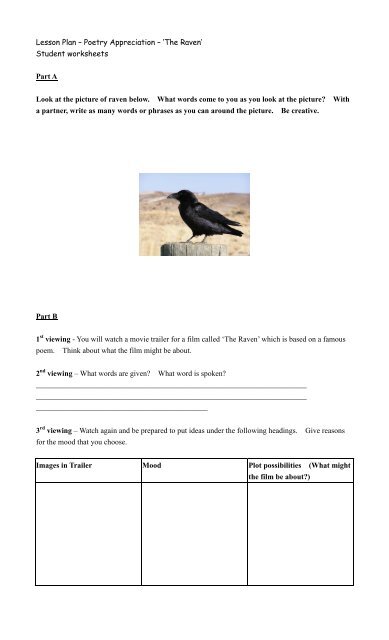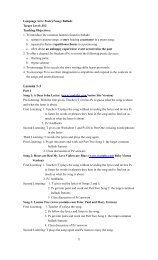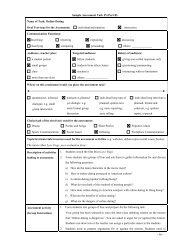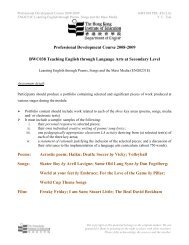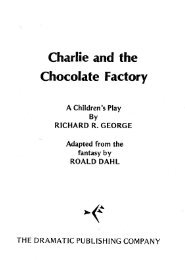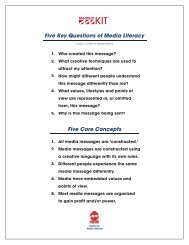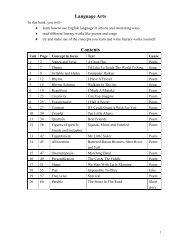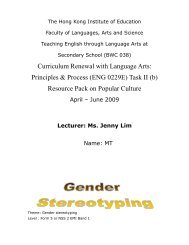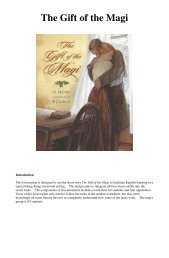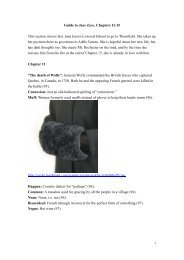You also want an ePaper? Increase the reach of your titles
YUMPU automatically turns print PDFs into web optimized ePapers that Google loves.
<strong>Lesson</strong> <strong>Plan</strong> – Poetry Appreciation – ‘The Raven’<br />
Student worksheets<br />
Part A<br />
Look at the picture of raven below. What words come to you as you look at the picture? With<br />
a partner, write as many words or phrases as you can around the picture. Be creative.<br />
Part B<br />
1 st viewing - You will watch a movie trailer <strong>for</strong> a film called „The Raven‟ which is based on a famous<br />
poem. Think about what the film might be about.<br />
2 nd viewing – What words are given? What word is spoken?<br />
_______________________________________________________________________<br />
_______________________________________________________________________<br />
_____________________________________________<br />
3 rd viewing – Watch again and be prepared to put ideas under the following headings. Give reasons<br />
<strong>for</strong> the mood that you choose.<br />
Images in Trailer Mood Plot possibilities (What might<br />
the film be about?)
Part C Translated version of ‘The Raven’<br />
‘The Raven’ is the title of a poem written by Edgar Allan Poe and published in 1845. Poe was<br />
famous <strong>for</strong> tales of horror and this poem has remained popular <strong>for</strong> more than 150 years now.<br />
The poem tells the story of a man who is sitting in his study late at night. He hears knocking at<br />
the door, but can’t see anyone there. Finally a raven (a big black bird) enters the room. Look<br />
at the translated version of the opening verses of the poem below.<br />
The Raven (translated by T. Gaughan)<br />
One cold and dark midnight a long time ago, I was thinking about many things while I tiredly looked at old books about<br />
ancient subjects. I was nodding over the books and nearly asleep when I heard a tapping sound at the door to the room. The<br />
sound surprised me, but I said to myself that it was just a visitor making the tapping sound, and nothing else.<br />
Thinking back now, I remember that it was in the middle of a bleak December. The fire had burned down until it was just red<br />
coals so there was not much light in the room, and I saw the shadows of the coal upon the floor. I wanted it to be day already.<br />
I couldn’t sleep because of my sadness over Lenore, and looking at my books didn’t help my state of mind.<br />
The purple curtains in the room moved slightly and filled me with fear. To calm myself I repeated over and over, “it is some<br />
visitor who wants to enter, a late visitor who wants to enter, and nothing else.”<br />
Soon I became less afraid and spoke to the door, “Sir or Madam, I’m sorry, but I was almost asleep and you knocked so lightly<br />
on the door that I almost couldn’t hear you.” Then I opened the door but there was nothing there.<br />
I stood and looked into the darkness <strong>for</strong> a long time. I felt very afraid, but there was no sound and everything was still. I<br />
whispered the word, “Lenore?” and heard a quiet echo, “Lenore.” I heard nothing else.<br />
Make a glossary of 6 words that you don’t know the meaning of, but you think are important to<br />
understanding the story. Use your dictionary to write the meanings. What part of speech is<br />
the word that you chose?<br />
Word Meaning<br />
ex. ancient<br />
1.<br />
2.<br />
3.<br />
4.<br />
5.<br />
6.<br />
-very old<br />
Look at the above passage. What in<strong>for</strong>mation can you find on the following?<br />
Characters<br />
Genre (Clues?)
Setting (both time and place) (Clues?)<br />
Summarise your ideas on the past (what happened be<strong>for</strong>e the story begins), present and future<br />
plot lines in just two sentences <strong>for</strong> each.<br />
What happened in the past? What is happening now? What will happen next?<br />
← →<br />
Listen to your teacher read the first stanza below. Then you will the stanza out loud.<br />
Part D First verse of ‘The Raven’ by Edgar Allan Poe<br />
Once upon a midnight dreary, while I pondered, weak and weary<br />
Over many a quaint and curious volume of <strong>for</strong>gotten lore --<br />
While I nodded, nearly napping, suddenly there came a tapping,<br />
As of someone gently rapping, rapping at my chamber door.<br />
" 'Tis some visitor, " I muttered, "tapping at my chamber door--<br />
Questions and Comments<br />
Only this and nothing more."<br />
1. Write the number of syllables <strong>for</strong> each line.<br />
a) line 1 _____ b) line 2 ____ c) line 3 ____ d) line 4 ____ e) line 5 ____ f) line 6 ____<br />
2. What is the poet doing when he gives the final line a small number of syllables?<br />
3. What is the rhyme scheme of the first verse? ____________________________________<br />
4. What words create the internal rhyme in line 1 and line 3?<br />
_________________ _____________________<br />
________________ _____________________
The poem has an extremely strong rhyme and syllable pattern. That means that when you read<br />
the poem out loud, you feel the strong beat of the poem. Through the whole poem, the feeling is<br />
that something is coming and the strong beat gives the sense that no one can stop the unknown<br />
thing from coming. In addition the poet repeats many lines, which also adds to this feeling.<br />
The poem (like all poems) MUST be read aloud to get the feeling the poet wants to express.<br />
Part E Second Verse of ‘The Raven’<br />
Ah, distinctly I remember it was in the bleak December;<br />
And each separate dying ember wrought its ghost upon the floor.<br />
Eagerly I wished the morrow -- vainly I had sought to borrow<br />
From my books surcease of sorrow -- sorrow <strong>for</strong> the lost Lenore--<br />
For the rare and radiant maiden whom the angels name Lenore--<br />
Questions and Comments<br />
Nameless here <strong>for</strong> evermore.<br />
The poet gives us more of the setting and his mood. He also increases the use of internal rhyme<br />
in the second verse.<br />
1. Write the number of syllables <strong>for</strong> each line.<br />
a) line 1 _____ b) line 2 ____ c) line 3 ____ d) line 4 ____ e) line 5 ____ f) line 6 ____<br />
2. There are three important rhymes in the second verse. What are the rhyming words <strong>for</strong> each?<br />
rhyme 1 rhyme 2 rhyme 3<br />
_____________________ _____________________ _____________________<br />
______________________ _____________________ _____________________<br />
______________________ _____________________ ______________________<br />
3. What does the last line of the verse mean?<br />
Part F More of the Poem<br />
And the silken, sad, uncertain rustling of each purple curtain<br />
Thrilled me -- filled me with fantastic terrors never felt be<strong>for</strong>e:<br />
So that now, to still the beating of my heart, I stood repeating.<br />
" 'Tis some visitor entreating entrance at my chamber door--<br />
Some late visitor entreating entrance at my chamber door--<br />
That it is and nothing more."<br />
Presently my soul grew stronger: hesitating then no longer,<br />
"Sir, " said I, "or Madam, truly your <strong>for</strong>giveness I implore:<br />
But the fact is I was napping, and so gently you came rapping,<br />
And so faintly you came tapping, tapping at my chamber door,<br />
That I scarce was sure I heard you"-- here I opened wide the door--<br />
Darkness there and nothing more.<br />
Deep into the darkness peering, long I stood there wondering fearing.<br />
Doubting, dreaming dreams no mortal ever dared to dream be<strong>for</strong>e:<br />
But the silence was unbroken, and the stillness gave no token,<br />
And the only word there spoken was the whispered word, "Lenore?"<br />
This I whispered, and an echo murmured back the word "Lenore!"--<br />
Merely this and nothing more.
Questions and Comments<br />
The narrator describes the movement of the curtains and how he begins to be afraid. Because<br />
the narrator is afraid, we the readers are beginning to be afraid. Darkness, silence and stillness<br />
greet the narrator, until he hears the echo of a whisper.<br />
1. Personification is when an object has human qualities. What words does the poet use to personify<br />
the curtains?<br />
2. Why does the narrator repeat the lines „Tis some visitor entreating entrance‟?<br />
3. Who is the narrator talking to in the middle stanza above?<br />
4. Why does the narrator say the word „Lenore‟?<br />
Part G ‘The Raven’ and Modern Culture<br />
Listen now to the opening of the poem recited by the excellent actor Christopher Lee.<br />
Further work – Choose one of the following:<br />
A) Listen to a rap version of „The Raven‟ on Youtube („The Raven Rap Remix). Do you prefer this<br />
version or the Christopher Lee version. Why?<br />
B) Listen to „The Raven Rap Remix‟ on Youtube. Write the opening stanza of your own rap. Start<br />
with the words “As I pondered.‟<br />
C) Compare 3 other recordings of the poem. Which one do you prefer and why? (some<br />
recommended include Edgar Allan Poe, Christopher Walken, James Earl Jones)<br />
D) Many famous books, films and poems are parodied. A „parody‟ is when something serious that<br />
everyone knows about is turned into something funny. For example, sometimes politicians are<br />
parodied on comedy programmes. The TV series, „The Simpsons‟ made a parody of „The Raven‟ <strong>for</strong><br />
a Halloween special in 1990. If you can locate that parody, it is worth watching. Or you may watch a<br />
Youtube parody of the poem using a man and his oven. Everything in the parody is made of lego.<br />
Type „The Oven (HD)‟ in the keyword search. What are the similarities?<br />
<strong>Lesson</strong> <strong>Plan</strong> – Poetry Appreciation – ‘The Raven’ (With links to Pop Culture)<br />
Teacher’s Worksheets<br />
Background:<br />
The poem „The Raven‟ by Edgar Allan Poe is a classic that was first published in 1845. Poe was<br />
famous <strong>for</strong> tales of horror and this poem has remained popular <strong>for</strong> more than 150 years now. The<br />
vocabulary is difficult and the lesson is suited <strong>for</strong> higher-ability students. However, the vocabulary is<br />
secondary to the objectives, and since only a few stanzas of the poem are looked at, it should not be<br />
seen as a huge obstacle.<br />
The target group is S3 or S4 students having good ability in English. The students should already be<br />
familiar with poetry and basic poetic devices. Only the first 5 stanzas of the poem will be looked at.
Objectives:<br />
–to introduce or re-emphasise the importance of syllable, meter, rhyme, rhythm in poetry<br />
-to look at the importance of imagery in conveying a message<br />
-to stimulate interest in poetry through the use of the horror genre (popular among students)<br />
-to show links between classic literature and pop culture<br />
-to push students to explore the emotion of a poem and to go beyond question-answer in their responses<br />
to it<br />
Part A<br />
Have students brainstorm words in partners or small groups. Have students put some of their answers<br />
on the board. Encourage answers that go beyond physical descriptions of the bird and use more<br />
abstract vocabulary.<br />
Examples:<br />
black, dark, evil, sinister, watchful<br />
quick, clever, graceful<br />
omen of bad luck<br />
scavenger, rubbish picker<br />
friendly, collects in flocks, noisy<br />
Part B<br />
1 st viewing of the video. Let the students watch the movie trailer at www.youtube.com (keywords –<br />
The Raven – Trailer Mejpye). Ask them <strong>for</strong> possible ideas as to what the film might be about.<br />
2 nd viewing – Once upon a midnight dreary (opening line of the poem)<br />
One man stood alone. (not a line in the poem)<br />
Spoken word is „Nevermore.‟<br />
Encourage students to think about possible setting (both time and place) and genre.<br />
3 rd viewing – Try to elicit reasons from students <strong>for</strong> their answers. For example, “Is it a love story?<br />
What does the body language tell us? The man has his back turned. The woman is looking down.”<br />
“Why is the man shot in darkness and the woman in light?”<br />
Images in Trailer Mood Plot possibilities<br />
-purple text on black background<br />
-indistinct view of a man – his<br />
back is turned to us and we<br />
cannot see his face<br />
-a half view of a woman’s face –<br />
she has closed eyes, or is looking<br />
down so we cannot see her<br />
clearly<br />
The mood is dark. The film may<br />
be tragic or frightening.<br />
Reasons we feel this mood are as<br />
follows:<br />
-the background music is<br />
haunting<br />
-the shots of people are unclear<br />
or broken so we cannot <strong>for</strong>m a<br />
clear impression<br />
-the word ‘nevermore’ is spoken<br />
in a low and unfriendly voice<br />
There may be many acceptable<br />
possibilities, but the answers must<br />
suit the genres of horror, tragedy,<br />
ghost, etc.
Part C Translated version of ‘The Raven’<br />
Turn off the lights to the classroom. Read the passage to the poems with drama. Have students<br />
work on the questions and then report back or write on blackboard. You may also want to look at<br />
words students chose <strong>for</strong> their glossary and point out that nouns and verbs are most important <strong>for</strong><br />
understanding meaning.<br />
Characters<br />
-narrator<br />
-Lenore? Genre<br />
-visitor? -horror/ mystery/ ghost<br />
-raven? The setting, the narrator’s fear,<br />
Setting (both time and place)<br />
-it is midnight in December<br />
the darkness, the unexplained echo<br />
all contribute to the mood.<br />
-the story happened long ago because the narrator<br />
is remembering<br />
-it is a house (a study and a visitor knocking)<br />
-it is northern hemisphere (cold, fire burning)<br />
What happened in the past? What is happening now? What will happen next?<br />
The narrator is sad The narrator cannot sleep. Something will enter the<br />
because of something He hears a knocking and room. It may be a ghost<br />
that happened to Lenore ← feels afraid but we don’t → or person or the raven.<br />
be<strong>for</strong>e the story began. ← know why. He opens → The reader may find out<br />
Perhaps she was his lover← the door but there is no → what happened to Lenore<br />
and she died. one there. and why the narrator is<br />
Part D First verse of ‘The Raven’ by Edgar Allan Poe<br />
sad, anxious and afraid.<br />
Read the poem to the students with the classroom lights off. Impress upon students that they do not<br />
need them to understand all the words. They should focus on feeling the mood and rhythm of the<br />
poem. The vocabulary of the poem is secondary to the purpose of the lesson. Students should focus<br />
on the beat, the repetition, the rhyme. If reluctant to read the poem, then there are many recordings of<br />
the poem on Youtube that may be used. The recording done by Christopher Lee (reference in Part G)<br />
is highly recommended.<br />
Once upon a midnight dreary, while I pondered, weak and weary<br />
Over many a quaint and curious volume of <strong>for</strong>gotten lore --<br />
While I nodded, nearly napping, suddenly there came a tapping,<br />
As of someone gently rapping, rapping at my chamber door.<br />
" 'Tis some visitor, " I muttered, "tapping at my chamber door--<br />
Only this and nothing more."
After reading it, have the students read the verse aloud. This should be done together and can be done<br />
phrase by phrase, line by line, or the whole stanza at once.<br />
Discuss the following comment on the student worksheet:<br />
The poem has an extremely strong rhyme and syllable pattern. That means that when you read the<br />
poem out loud, you feel the strong beat of the poem. Through the whole poem, the feeling is that<br />
something is coming and the strong beat gives the sense that no one can stop the unknown thing from<br />
coming. In addition the poet repeats many lines, which also adds to this feeling. The poem (like all<br />
poems) MUST be read aloud to get the feeling the poet wants to express.<br />
Questions<br />
1. Write the number of syllables <strong>for</strong> each line.<br />
a) line 1 _16__ b) line 2 _16_ c) line 3 _16_ d) line 4 _15_ e) line 5 _15_ f) line 6 __7_<br />
2. What is the poet doing when he gives the final line a small number of syllables?<br />
He is making us read it more slowly. He is giving it more importance/ more emphasis.<br />
3. What is the rhyme scheme of the first verse? ___a, b, c, b, b, b______<br />
4. What words create the internal rhyme in line 1 and line 3?<br />
___dreary______ ____weary_____<br />
___napping_____ ___tapping___<br />
Part E Second Verse of ‘The Raven’<br />
Ah, distinctly I remember it was in the bleak December;<br />
And each separate dying ember wrought its ghost upon the floor.<br />
Eagerly I wished the morrow -- vainly I had sought to borrow<br />
From my books surcease of sorrow -- sorrow <strong>for</strong> the lost Lenore--<br />
For the rare and radiant maiden whom the angels name Lenore--<br />
Questions and Comments<br />
Nameless here <strong>for</strong> evermore.<br />
1. Write the number of syllables <strong>for</strong> each line.<br />
a) line 1 __16_ b) line 2 _15_ c) line 3 _16_ d) line 4 _15_ e) line 5 _15_ f) line 6 _7_<br />
2. There are three important rhymes in the second verse. What are the rhyming words <strong>for</strong> each?<br />
rhyme 1 rhyme 2 rhyme 3<br />
___remember_________ ___morrow__________ ___floor________<br />
____December_________ ___borrow___________ ___Lenore_______<br />
_____ember___________ ___sorrow___________ ___evermore_____<br />
3. What does the last line of the verse mean?<br />
The narrator is not going to mention Lenore’s name again.
Part F More of the Poem<br />
And the silken, sad, uncertain rustling of each purple curtain<br />
Thrilled me -- filled me with fantastic terrors never felt be<strong>for</strong>e:<br />
So that now, to still the beating of my heart, I stood repeating.<br />
" 'Tis some visitor entreating entrance at my chamber door--<br />
Some late visitor entreating entrance at my chamber door--<br />
That it is and nothing more."<br />
Presently my soul grew stronger: hesitating then no longer,<br />
"Sir, " said I, "or Madam, truly your <strong>for</strong>giveness I implore:<br />
But the fact is I was napping, and so gently you came rapping,<br />
And so faintly you came tapping, tapping at my chamber door,<br />
That I scarce was sure I heard you"-- here I opened wide the door--<br />
Darkness there and nothing more.<br />
Deep into the darkness peering, long I stood there wondering fearing.<br />
Doubting, dreaming dreams no mortal ever dared to dream be<strong>for</strong>e:<br />
But the silence was unbroken, and the stillness gave no token,<br />
And the only word there spoken was the whispered word, "Lenore?"<br />
This I whispered, and an echo murmured back the word "Lenore!"--<br />
Questions and Comments<br />
Merely this and nothing more.<br />
1. Personification is when an object has human qualities. What words does the poet use to personify<br />
the curtains?<br />
sad, uncertain<br />
2. Why does the narrator repeat the lines „Tis some visitor entreating entrance‟?<br />
The narrator repeats the lines to calm himself/ to slow down the fast beating of his heart (to still the<br />
beating)/ to convince himself that it is true.<br />
3. Who is the narrator talking to in the middle stanza above?<br />
He is talking to the unknown person he thinks has come to visit him.<br />
4. Why does the narrator say the word „Lenore‟?<br />
He wonders if it is her ghost who has knocked/ He wonders if she may still be alive, despite his<br />
fears.<br />
Part G ‘The Raven’ and Modern Culture<br />
Go the www.youtube.com and type in the keywords, The Raven – Read by Christopher Lee. Play the<br />
first 5 stanzas. You may want to play others, including a recording of Edgar Allan Poe himself. If<br />
you have access to the „Simpsons Halloween Special‟ episode entitled „Treehouse of Horror,‟ there is a<br />
wonderful parody of „The Raven‟ that can be shown.<br />
Additional work <strong>for</strong> the students may be assigned.


